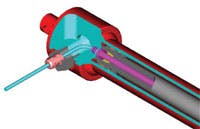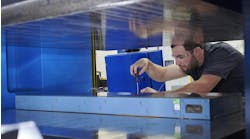Defense equipment isn’t necessarily used only during political conflicts. When earthquakes, floods, or other natural disasters occur, armed forces often are called on to assemble quickly with large numbers of trained personnel and heavy equipment. Debris is cleared away to restore lines of communication so that relief supplies can be brought through and distributed to those in greatest need.
The FV180 Combat Engineer Tractor, designed by BAE Systems, Farnborough, UK, has become the standard vehicle of its class in the British Army. More recently, BAE Systems was awarded a contract for the design, development, and production of the more-capable Terrier Maneuvre Support Vehicle (MSV). MSVs can undertake a much wider range of battlefield operations than today’s FV180 CET, which was originally conceived more than 30 years ago.
The first prototype of Terrier was rolled out at the Land Systems Leicester facility in mid-2005 and has since been engaged in a demanding series of trials at various locations in the UK. BAE Systems built four pre-series Terriers in 2007, and about 65 production vehicles will follow — with the first batch of 20 to be delivered by late 2009.
What it is
Terrier is a tracked vehicle fitted with a front-mounted, hydraulically operated bucket that can be used to clear obstacles, prepare vehicle and weapon pits, and grip large objects. A ripper can be fitted to break up road surfaces.
Mounted on the right side is a hydraulically operated excavator arm system that can lift a maximum of 3 tons at full reach. Normally fitted with a bucket, the arm can be used to prepare infantry trenches. However, the bucket can be replaced quickly by other specialized attachments, such as an auger that can drill holes to 3-m deep, or an impact hammer-breaker. A rear load platform can carry payloads to 5 tons.
Despite all this versatile tooling, the Terrier is light enough to be carried in an A400M aircraft, and two can be carried in a C-17 aircraft.
An electronic interface
A key element of the Terrier’s success is electronic control, and to interface with electronics, hydraulic cylinders require some sort of linear displacement transducer (LDT). Magnetostrictive transducers have gained widespread use as an LDT, especially in stationary applications. High production machines that require positioning accuracy to within thousandths of an inch justify the cost of a magnetostrictive LDT.
However, Mark Hoffman, of Rota Engineering, Dallas, points out that because mobile equipment has a human operator, position feedback from cylinders generally only needs to be within hundredths of an inch. Put simply, he says that magnetostrictive LDTs are overkill for most mobile equipment applications. He suggests that an LDT with slightly less precision, but substantially lower cost, would enable designers to provide cylinder position feedback more often — not just for the most critical applications that justify high cost.
Hall-effect technology
LDTs from Rota Engineering use a microprocessor that transmits and receives signals from Hall-effect chips mounted to a printed circuit board. The circuit board is contained within a stainless steel or aluminum housing, depending on application requirements. A piston-mounted magnet causes a voltage drop when it passes over the Hall-effect chip. The microprocessor calculates the position of the Hall-effect chip and correlates the voltage drop to a proportional voltage, current, PWM, or CANBUS output.
Hoffman explains, “Hall-effect sensors do not have as high a resolution as magnetostrictive sensors which can achieve resolution measured in ten-thousandths of an inch. Hall-effect LDTs, however, generally have resolution of 0.012 to 0.020 in. The tighter resolution of magnetostrictive LDTs is needed for many process applications, such as a rolling mill. Most of the time, though, 0.020 in. resolution is more than sufficient for mobile hydraulic applications.”
An additional benefit of the Hall-effect technology is small size. In most instances, the pin-to-pin dimension of a cylinder need not be increased to accommodate a Hall-effect LDT. Also, the surface-mount technology tolerates high levels of vibration, and potting can provide additional vibration resistance.
Hoffman continues, “The transducers used in the Terrier allow automatic stowing of the excavator arm when it is not needed. They also allow remote operation when the vehicle comes under fire from small arms. Since the original design, we developed a more compact transducer, which will be used on production vehicles. The Terrier has been on field trials for at least a year and has come under some severe conditions of shock and vibration.
“The Terrier vehicle still has its original set of our Hall-effect transducers, which were installed about three years ago. They have worked without failure inside the compact and lightweight cylinders designed by Parker in Germany.”
For more information on Rota Engineering’s Hall-effect LDTs, contact Mark Hoffman at (972) 359-1041, or e-mail [email protected] or visit www.rota-eng.com.
Click here to see a video showing the FV180 in action.



